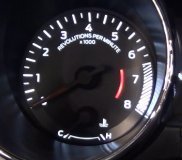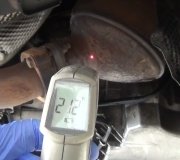You have the luxury of learning from me! This happened twice to my cars with carburetors, and twice to my rusty trusty 1988 Grand Caravan. The part cost $3.00 for the two older cars. It just slid onto the pickup tube in the gas tank. The screen for my Grand Caravan costs $12.00 and snaps onto the housing the fuel pump sits in inside the tank. You will need to lower the gas tank which is best done after you run the gas out or siphon it out. I do not work on Fords but if you plan on doing more repairs yourself, invest in a paper copy of the manufacturer's service manual, not a Chilton's or Haynes manual. You can find these on eBay all the time. I bought a lot of Ford manuals for my classroom from a seller that does or used to go by the name of "Lorieandjeff", and later by "Blackhatauctions". They attend lots of dealership auctions all over the country and resell the books and special tools. They have a real lot of Ford stuff.
The manual will describe how to remove the fuel pump from the tank. I use the Rock Auto web site every day for reference. You can look up the part for your car to see what it looks like. It is real inexpensive but you have to add shipping. They call it a "strainer". I call it a screen. You are likely to find this in stock at your local auto parts stores too. The part for my Grand Caravan was in stock both times. The screen for my older cars were in stock both times when I worked at a very nice family-owned Chrysler dealership in the 1990's.
Before you dive into this, I would want to be sure it is the best suspect, and that is where watching the fuel pressure gauge is important. It would be the pits to go through all this work on my recommendation, then find out it did not solve the problem. If fuel pressure remains solid, (it will fluctuate based in varying intake manifold vacuum), another good thing to look at on every brand of car except Chrysler products is the fresh air tube between the mass air flow sensor and the throttle body. There cannot be any cracks, loose hose clamps, or other leaks in that tube. If any air sneaks in that does not go through the mass air flow sensor, the engine computer will not know about it, and it will not include enough fuel in the fuel metering calculations. Chrysler is the only manufacturer that never needed a mass air flow sensor to make their engines run right, so vacuum leaks do not affect engine performance that much.
To really shift gears for a minute, follow the smaller battery positive wire to the under-hood fuse box and be sure that connection is clean and tight. Follow the smaller negative battery wire to the body and be sure that connection is tight and not rusty. Those are common causes of intermittent electrical problems, including all the way up to a stalling engine, on any brand of car.
Beyond this, if nothing pans out up to this point, you will need a scanner to view live data during a test-drive. You can watch sensor readings and see how the computer responds. Most better scanners have a "record" feature that lets you record a few seconds of sensor data. You press the button when the problem occurs, then you can play it back slowly, later, to see what changed. Because the data goes through the scanner's memory, the recording actually starts a couple of seconds before you pressed the button.
I have a Chrysler DRB3 for all of my cars. A lot of independent shops bought them because with an extra plug-in card, it will do emissions-related stuff on any brand of car sold in the U.S. Starting with 1996 models. They are becoming obsolete now so you may find these at some local shops. They may be thrilled to sell theirs so they can buy something newer, but I do not recommend this for you. Everything it will do on your car is less than five percent of what it can do on Chrysler products. Ford does not have a dealer-level scanner that is practical for homeowners and do-it-yourselfers. For that, my friend has a Snapon Solus Edge that will work on most car brands. I will not buy Snapon equipment because of the customer-unfriendly business practice of grossly overcharging for annual updates, but that can work to your advantage. This model costs around $4,000.00 new, which sounds like a lot, but it is only slightly more than I paid for my DRB3's. Where they stick you is the annual updates cost $1,000.00, and you cannot skip any years. For that reason, these lose their value very quickly, and you can pick one up on eBay for around $800.00. For example, if you find one that has been updated to 2012, that is way more than good enough for your 1998 model. If a shop owner bought it for his business, he would be required to buy the 2013 update, the 2014 update, the 2015 update, the 2016 update, and the 2017 update before he could buy the 2018 update so it would work on the latest cars. Why buy $6,000.00 worth of updates when he could buy a brand new scanner with the latest updates for $4,000.00? This is why they lose their value for shop owners but they can be a good deal for you and me.
There are other brands of scanners that will work on your car. Consider asking at any local repair shop when their tool truck guys show up. Most visit each shop the same time each week, for an hour. The mechanics are usually in a hurry so you might have to wait until they are done, then the driver will be happy to show you what he has in his "used" drawer. Very often he is going to sell a new scanner to a mechanic once he can find a buyer for the mechanic's old trade-in. Once you use a quality scanner a few times, you will be amazed at what you could not do before without it.
Saturday, January 20th, 2018 AT 11:56 PM


